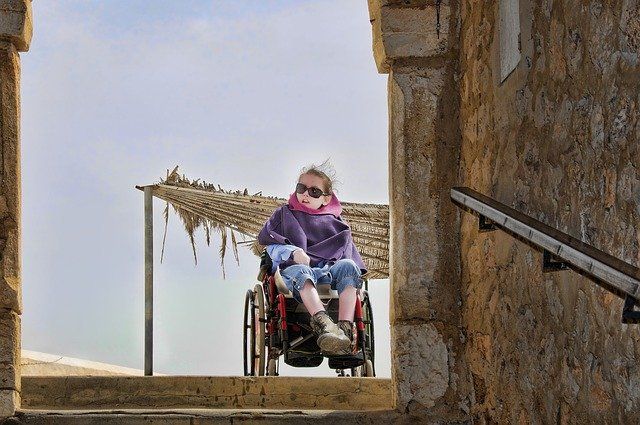
There are an estimated 6.5 million disabled people in Britain, most of whom have acquired some form of impairment as adults and also happen to be elderly. They include people with various forms of arthritis, paralysis following disease or injury, and varying degrees of hearing or visual impairment. If the entire world’s population of disabled people were to form a single nation, it would be the world’s third largest, the poorest and the least evangelised. This article sets out to examine what disability is, and how it affects churches.
What is disability?
To define what is meant by ‘disability’ is difficult. Disability is often seen as a medical phenomenon similar to illness, but this perspective has been challenged by disabled people and health professionals alike. Traditionally, disability has been seen as an individual medical condition, which gives rise to a practical problem, for example, an inability to climb steps. Looked at another way however, it is the steps that are at fault! If there were no steps, the problem would disappear. It is not so much unconventional bodies or methods of locomotion that cause ‘disability’, as the built environment, which is relatively hostile to disabled people.

Attitudes are important
Historically, there has been some ambivalence within churches concerning disability. It has sometimes been attributed to individual sin, and sometimes to divine favour! This confusion, compounded by the notion of virtuous suffering, has often left Christians uncertain about how they should respond. Should we feel pity, fear or neither?
While there are people from all walks of life, and in many spiritual states, who are disabled, they are essentially ordinary sinners, either saved by grace or in need of grace. Jesus mixed with all types of people and did not reject them on the grounds of bodily or intellectual inadequacy.
If we routinely respond to disabled people in a particular way, we may unconsciously be applying negative stereotypes. I need to remember that the person who happens to be disabled is also my neighbour, someone’s elderly mother, the baby just born to a young couple or, quite possibly, myself. How many of us could read or drive without spectacles? Others in the congregation, in spite of being fully alert and keen, may not be able to hear the sermon or read the hymnbook. Through illness or ageing, and the resultant impairments, our bodies may not work as smoothly as they once did. In spite of this, and quite understandably, we are reluctant to think of ourselves as ‘disabled’. But it is only a matter of degree, and we should be careful not to think of the disabled as belonging to a different race.
Of course, there are people who, through congenital conditions, have lived with disability since birth. Conditions like Down’s syndrome, cerebral palsy or muscular dystrophy become part of their identity. Christians and local churches should take note, since barriers to such people, either in our buildings or our attitudes, may serve to alienate them and their families.
Promoting inclusion
There are a number of organisations, both Christian and secular, working to promote the inclusion of dis-abled people, both in terms of access and activities. Churches for all, a recent campaign with just such an agenda, is supported by organisations like Torch Trust, Evangelical Concern for People with Disabilities, Deaf Church Network and Through the Roof, to mention just a few. If a local church currently has few disabled people attending, or if there is no particular ministry amongst disabled people, this fact alone should lead us to review the situation.

However, rather than start initiatives which compartmentalise ‘the disabled’, there are a number of simple ways that inclusion can be actively promoted. Steps and doors, or the car park terrain, may present insurmountable barriers to wheelchair users and others with reduced mobility. Once inside, such people may find doorways and toilets inaccessible. Building regulations for new buildings or extensions will, in future, ensure that structural barriers are avoided, but what about older buildings?
For existing churches, there are helpful publications. These, for example, give advice for the construction of ramps. A gentle ramp up to the entrance may defeat its object unless a flat surface is provided at the top. Where structural alterations would be difficult, a portable metal ramp may suffice.
The deaf
According to the Royal National Institute for the Deaf, there are around 8.7 million people in the UK with a hearing loss. Such people may be helped in church by a sound system and, just as important, a good microphone technique. People with a greater degree of hearing impairment, including those who use hearing aids, are likely to derive benefit from either an induction loop or infra-red system. An induction loop is the cheaper option, and consists of a cable installed around the seating area of the church and a special amplifier. People with a hearing aid must adjust it to the ‘t’ position.

There are evangelical groups with a specific ministry to deaf people, and some congregations have sign-language interpretation of services. It should be recognised that people whose first language is British Sign Language (BSL) may not have a good grasp of written English. It may also be useful to have some members who can communicate via the manual alphabet using simple finger signs.
The blind
There are very few blind people who can see nothing at all but there are approximately one million people with severe visual impairment in the UK, caused by many different eye conditions. Bright lighting helps, and using sharply contrasting colours between doors, walls and seating will assist many. Leading a blind person is not a natural skill, and the general rule is to ask the person concerned for instructions. Many hymn-books can be obtained in large print or Braille. Particular care must be taken where an overhead projector is used, since unskilled use can hinder even the keen-sighted and will certainly make life difficult for those with visual impairment. Alternative formats should always be readily available, or else some may be excluded from this part of the worship. Use of over-head projector requires preparation and forethought, with the provision of paper copies as an alternative.
Disability Discrimination Act 1995
Under this act, which expressly includes churches, it is illegal to provide goods or services to a lower standard, or to treat people less favourably, because they are disabled. Its provisions are being introduced over a number of years. In time, however, service providers will be required to provide auxiliary aids, such as an infra-red system, to allow disabled people to participate fully in the service. The final provision, due to be implemented by the year 2004, will make structural alterations necessary where there are physical barriers to the premises.

Local church leaders will need to gain a basic understanding of this legislation, and would do well to review their own practice in the light of the various special needs of disabled people. There may be members who have some personal experience of disability, who can take a lead. At the very least, a range of disabled people should be involved in consultations, and this may include inviting outsiders, for example, from members’ families or from disability organisations, to assist the church in a genuine review.
It must be remembered that whilst a disabled person has essential insights into some aspect of church life and disability, they are unlikely to be experts in relation to other issues. All members can be encouraged to gain at least a minimal awareness of facts concerning disability, whilst others are encouraged to develop specific communication or other skills. An increase in awareness and action is called for if the churches are to lead the way in promoting inclusion of disabled people in society and in the life of the churches.
Is it relevant?
The danger is that Christians may simply file this information away, as ‘interesting but not very relevant’. Yet it demands some form of response along with the ‘urgent and very important’ issues that affect church life. Sunday worship is only one aspect of church life. Roles as diverse as Bible study leader, Sunday-school teacher, communion steward and chorister should not be barred to people simply because they are disabled. The act lays down a minimum standard to be aimed for. But surely we should seek to do the very best we can for the Lord’s sake. There is no shortage of information to help us ensure that disabled people receive a positive welcome. Let the churches be for all













